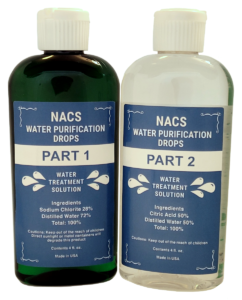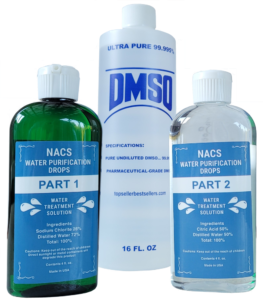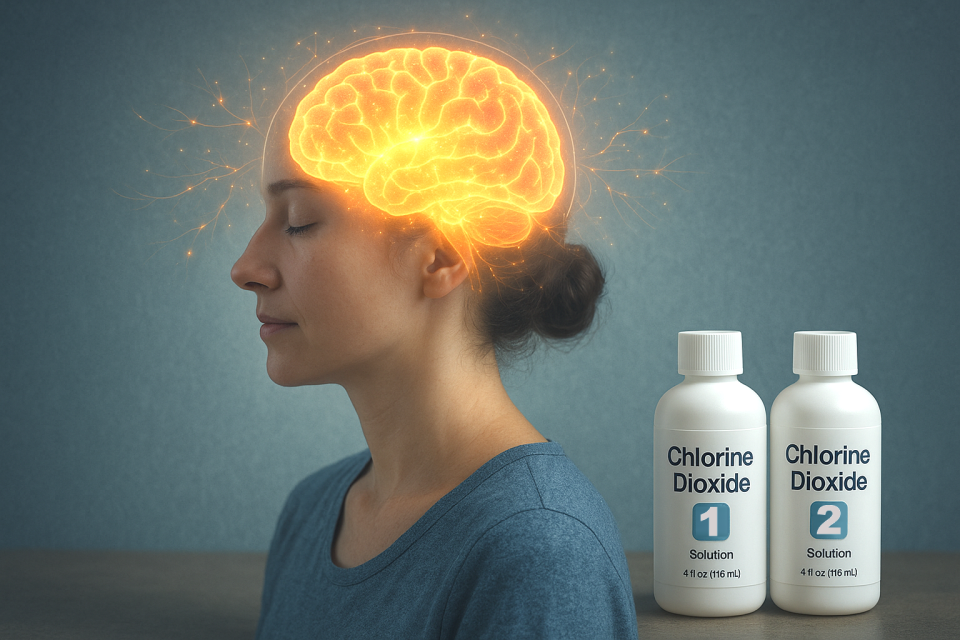Neurological and cognitive disorders represent some of the most challenging and least curable conditions known to modern medicine. They affect the brain, nerves, cognition, mood, and overall quality of life. Reports and observations from practitioners around the world have shown that chlorine dioxide, a powerful yet selective oxidizer, can play an unexpected role in supporting neurological and cognitive function when used responsibly as a non-medical, water purification supplement.
Chlorine dioxide (ClO₂) has long been recognized for its ability to purify water by destroying bacteria, viruses, fungi, and biofilms. Within the body, it appears to act similarly by oxidizing harmful pathogens, metals, and neurotoxins without damaging healthy tissues. While its use for internal health is considered an “off-label” and self-directed approach, many individuals have reported profound changes in clarity, mood, and overall brain function.

Below are the most commonly discussed neurological and cognitive disorders reportedly showing improvement with chlorine dioxide use.
- Alzheimer’s Disease
Description: A degenerative brain disorder leading to memory loss, confusion, and impaired reasoning.
Symptoms: Forgetfulness, disorientation, difficulty recognizing loved ones, and loss of independence.
How Chlorine Dioxide Helps: Alzheimer’s has been linked to chronic inflammation, metal toxicity, and microbial biofilms in the brain. Chlorine dioxide’s oxidative mechanism may help reduce pathogenic load and oxidative stress, clearing micro-toxins and restoring cellular oxygen balance.
Suggested Use: Following Jim Humble’s Protocol 1000—8-hour dosing of activated drops diluted in pure water—taken hourly in small amounts throughout the day for 3 weeks, has been associated with noticeable clarity and reduced confusion.
- Parkinson’s Disease
Description: A progressive nervous system disorder affecting movement and coordination.
Symptoms: Tremors, stiffness, slowness of movement, impaired posture, and speech changes.
How Chlorine Dioxide Helps: Parkinson’s involves both heavy metal accumulation and oxidative stress in neural tissue. Chlorine dioxide’s gentle oxidation appears to neutralize toxic residues, support detoxification, and restore mitochondrial function.
Suggested Use: Protocol 1000 combined with the topical application of a diluted chlorine dioxide and DMSO mixed solution on the neck and spine has been reported to improve neuromuscular response in many cases.
- Bipolar Disorder
Description: A mood disorder causing alternating episodes of mania and depression.
Symptoms: Emotional highs (mania) and lows (depression), irritability, impulsiveness, and fatigue.
How Chlorine Dioxide Helps: Users report a more balanced mood after detoxifying with chlorine dioxide, suggesting that the compound may assist in clearing neurotoxins or gut-derived pathogens influencing serotonin and dopamine levels.
Suggested Use: Begin with a low-dose protocol to detoxify gradually, paired with a clean diet and adequate hydration to support toxin elimination.
- Depression
Description: A chronic mood disorder characterized by persistent sadness and loss of interest.
Symptoms: Fatigue, lack of motivation, feelings of hopelessness, sleep changes, and appetite disturbance.
How Chlorine Dioxide Helps: By removing low-level chronic infections, microbial metabolites, and environmental toxins, chlorine dioxide helps restore the brain’s biochemical balance and oxygenation—often resulting in a lift in mood and vitality.
Suggested Use: Oral micro-dosing protocol for 14–21 days, with rest days as needed. Topical chlorine dioxide/DMSO application to the wrists or spine has been used to improve energy circulation.
- Anxiety
Description: Excessive worry, fear, or tension that can interfere with daily functioning.
Symptoms: Restlessness, heart palpitations, muscle tension, and difficulty concentrating.
How Chlorine Dioxide Helps: Many users describe a sense of calm and reduced “mental static” as chlorine dioxide clears systemic toxins and supports oxygen flow. Improved gut health, often referred to as the “second brain,” may reduce anxiety through the healing of the gut-brain axis.
Suggested Use: Low-dose continuous oral dosing (Protocol 1000) and vaporized application in room diffusers have shown supportive effects in cleansing the environment.
- Schizophrenia
Description: A severe mental disorder involving delusions, hallucinations, and disorganized thinking.
Symptoms: Hearing voices, paranoia, erratic behavior, and withdrawal from reality.
How Chlorine Dioxide Helps: Emerging hypotheses suggest a connection between schizophrenia and microbial and parasitic activity in neural tissue. Chlorine dioxide’s selective oxidation can help dismantle these microbial networks, potentially lessening neurological inflammation.
Suggested Use: Begin with minimal dosing (Protocol 1000) while maintaining strong nutritional support, including vitamin C, magnesium, and hydration, to buffer detox reactions.
- Autism Spectrum Disorder (ASD)
Description: Developmental condition affecting communication, behavior, and sensory processing.
Symptoms: Speech delay, repetitive behaviors, sensory sensitivity, and social difficulties.
How Chlorine Dioxide Helps: Autism-related studies and parent reports (notably by Kerri Rivera and others) suggest that chlorine dioxide may reduce microbial and parasitic burdens, improve digestion, and enhance neurological coherence.
Suggested Use: The CD Autism Protocol (micro-dosing every hour with careful observation) combined with a clean diet, probiotics, and mineral support has been widely discussed in autism recovery communities.
- Amyotrophic Lateral Sclerosis (ALS / Lou Gehrig’s Disease)
Description: A progressive neurodegenerative disease affecting motor neurons.
Symptoms: Muscle weakness, difficulty speaking, swallowing, and breathing.
How Chlorine Dioxide Helps: ALS is associated with oxidative damage and heavy metal toxicity. Chlorine dioxide’s redox action neutralizes free radicals and supports detoxification pathways, potentially slowing progression.
Suggested Use: Oral protocol paired with light skin chlorine dioxide/DMSO applications on the neck and upper spine to increase systemic oxygenation.
- Dementia
Description: A general term for memory and reasoning decline severe enough to interfere with daily life.
Symptoms: Memory loss, confusion, trouble with communication, and mood changes.
How Chlorine Dioxide Helps: Similar to Alzheimer’s, dementia often involves low-grade infection, vascular congestion, and reduced oxygenation. Chlorine dioxide acts as an oxygen carrier, enhancing brain circulation and clarity.
Suggested Use: Standard oral micro-dose protocol for 3–4 weeks, followed by maintenance doses as needed.
- General Neuro-Cognitive Difficulties
Description: Mild but persistent issues with memory, focus, learning, and mental energy.
Symptoms: “Brain fog,” lack of concentration, slow recall, and cognitive fatigue.
How Chlorine Dioxide Helps: As a systemic purifier, chlorine dioxide assists in clearing heavy metals, pathogens, and mycotoxins that interfere with neurotransmission. Users commonly report improved focus, clarity, and stamina.
Suggested Use: A gentle 14-day detox regimen using diluted chlorine dioxide solution, followed by maintenance micro-dosing and hydration.

How Chlorine Dioxide Works on Neurological Disorders
Chlorine dioxide does not act as a drug; it does not directly stimulate or suppress the brain. Instead, it supports internal housekeeping by:
- Breaking down microbial biofilms that clog neural pathways.
- Oxidizing heavy metals and chemical residues that impair neurotransmission.
- Increasing oxygen delivery to the brain tissue.
- Supporting detoxification and immune normalization.
This indirect action allows the body’s natural repair systems to restore neurological balance.
Supportive Data and Observations
- Spanish physician Dr. Manuel Aparicio-Alonso has published case reports of neurological symptom improvement among patients using chlorine dioxide under observation.
- Kerri Rivera’s Autism recovery program (spanning over 3,000 children) reported significant behavioral and communicative improvements through low-dose chlorine dioxide protocols.
- Field practitioners have observed marked improvement in clarity, emotional balance, and mobility among Alzheimer’s and Parkinson’s patients using self-administered chlorine dioxide regimens.
- Anecdotal evidence from support groups suggests increased calmness, reduction in tremors, and restoration of cognitive sharpness.
While more formal studies are warranted, the consistency of reports suggests that chlorine dioxide supports neurological integrity by addressing underlying toxic burdens and enhancing oxygenation, two universal needs for healthy brain function.

Safety and Considerations
Chlorine dioxide should always be used in very low concentrations and prepared according to safe activation protocols (as per Jim Humble’s MMS guidelines). It is for water purification purposes only, and any internal or topical use is at the user’s own discretion. Adequate hydration, mineral support, and rest are essential during detoxification periods.
References
- Humble, J. (2016). The Master Mineral Solution of the Third Millennium.
- Rivera, K. (2013). Healing the Symptoms Known as Autism.
- Aparicio-Alonso, M. (2020). Clinical Observations on Chlorine Dioxide Applications.
- Taylor, J. M. (2019). “Oxidative Mechanisms in Neurodegenerative Disorders.” Neuroscience Today.
- Humble, P. (2022). Healthy Alternative Chlorine Dioxide Uses Non-pharmacological Health Restoration.
- Rivera, K., & Humble, J. (2020). “Case Studies on Chlorine Dioxide in Cognitive and Behavioral Disorders.” Alternative Healing Review.
